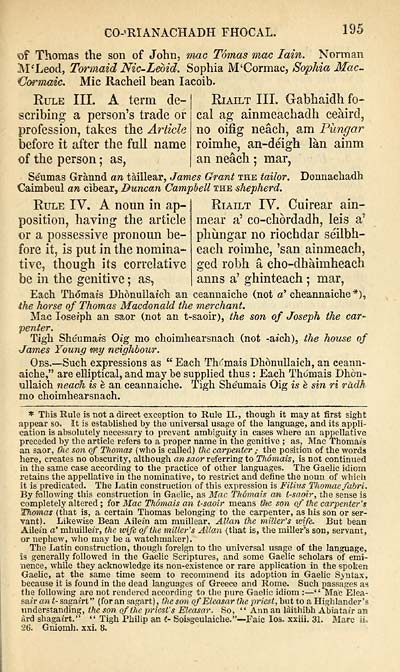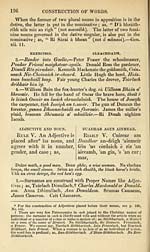Books and other items printed in Gaelic from 1841 to 1870 > Stéidhean a' Ghràmair Ghaëlig
(223) Page 195
Download files
Complete book:
Individual page:
Thumbnail gallery: Grid view | List view

CO-*MANACHADH FHOCAL.
195
of Thomas the son of John, mac Tòmas mac lain. Norman
M'Leod, Tormaid Nic-Leòìd. Sophia M'Cormac, Sophia Mac-
Vormaic, Mic Racheil bean lacoib.
Riailt III. Gabhaidh fo-
Rule III. A term de-
scribing a person's trade or
profession, takes the Article
before it after the full name
of the person ; as,
cal ag ainmeachadh ceàird,
no oifig neàch, am Piingar
roimhe, an-dèigh làn ainm
an neach ; mar,
Seumas Grànnd an tàiìlear, James Grant the tailor. Donnachadh
Caimbeul an cìbear, Duncan Campbell the shepherd.
Rule IV. A noun in ap-
position, having the article
or a possessive pronoun be-
fore it, is put in the nomina-
tive, though its correlative
be in the genitive ; as,
Riailt IV. Cuirear ain-
mear a' co-chòrdadh, leis a'
phùngar no riochdar sèilbh-
each roimhe, 'san ainmeach,
ged robh à cho-dhàimheach
anns a' ghinteach ; mar,
Each Thdmais Dhònullatch an ceannaiche (not a' cheannaiche *),
the horse of Thomas Macdonald the merchant.
Mac Ioseiph an s&or (not an t-saoir), the son of Joseph the car~
penter.
Tigh Sheumais Oeg mo choimhearsnach (not -aich), the house of
James Young my neighbowr.
Obs. — Such expressions as " Each Thi'mais Dhònullaich, an ceann-
aiche," are elliptical, and may be supplied thus : Each Thomais Dhòn-
ullaich neach is è an ceannaiche. Tìgh Sheumais Oig is è sin ri ràdh
mo choimhearsnach.
* This Rule is not adirect exception to Rute II., though it may at first sight
appear so» It is established by the universal usage of the language, and its appli-
cation is absolutely necessary to prevent ambiguity in cases where an appellative
preceded by the article refers to a proper name in the genitive ; as, Mac Thoma/s
an saor, the son of Thomas (who is called) the carpenter ; the position of the words
here, creates no obscurity, although an saor referring to Thomais, is not continued
in the same case according to the practice of other languages. The Gaelic idiom
retains the appellative in the nominative, to restrict and define the noun of which
it is predicated. The Latin construction of this expression is Filius Thomae fabri.
By following this construction in Gaelic, as Mac Thòmais an t-saoir, the sense is
completely altered ; for Mac Thòmais an t-saoir means Ute son of the carpenter's
Thotnas (that is, a certain Thomas belonging to the carpenter, as his son or ser-
vant). Likewise Bean Ailein am muillear, Allan the miller's wife. But bean
Ailem a' mhuilleù*, the wìfe ofthe miller's Allan (that is, the miller's son, servant,
or nephew, who may be a watchmaker).
The Latin construction, though foreign to the universal usage of the language,
ìs generally followed in the Gaelic Scriptures, and some Gaelic scholars of emi-
nence, while they acknowledge its non-existence or rare application in the spoken
Gaelic, at the same time seem to recommend its adoption in Gaelic Syntax,
because it is found in the dead languages of Greece and Rome. Such passages as
the following are not rendered according to the pure Gaelic idiom : — " Mac Elea-
saù- an t- sagaùt" (for an sagart), the son of Eleasar the priest, but to a Highlander's
understanding, the son ofthe priest's Eleasar. So, " Ann an làithibh Abiataù an
àrd shagai'rt." " Tigh Philip an t- Soisgeulaiche." — Faic Ios. xxiii. 31. Marc ii^
26. Gniomh. xxi. 8.
195
of Thomas the son of John, mac Tòmas mac lain. Norman
M'Leod, Tormaid Nic-Leòìd. Sophia M'Cormac, Sophia Mac-
Vormaic, Mic Racheil bean lacoib.
Riailt III. Gabhaidh fo-
Rule III. A term de-
scribing a person's trade or
profession, takes the Article
before it after the full name
of the person ; as,
cal ag ainmeachadh ceàird,
no oifig neàch, am Piingar
roimhe, an-dèigh làn ainm
an neach ; mar,
Seumas Grànnd an tàiìlear, James Grant the tailor. Donnachadh
Caimbeul an cìbear, Duncan Campbell the shepherd.
Rule IV. A noun in ap-
position, having the article
or a possessive pronoun be-
fore it, is put in the nomina-
tive, though its correlative
be in the genitive ; as,
Riailt IV. Cuirear ain-
mear a' co-chòrdadh, leis a'
phùngar no riochdar sèilbh-
each roimhe, 'san ainmeach,
ged robh à cho-dhàimheach
anns a' ghinteach ; mar,
Each Thdmais Dhònullatch an ceannaiche (not a' cheannaiche *),
the horse of Thomas Macdonald the merchant.
Mac Ioseiph an s&or (not an t-saoir), the son of Joseph the car~
penter.
Tigh Sheumais Oeg mo choimhearsnach (not -aich), the house of
James Young my neighbowr.
Obs. — Such expressions as " Each Thi'mais Dhònullaich, an ceann-
aiche," are elliptical, and may be supplied thus : Each Thomais Dhòn-
ullaich neach is è an ceannaiche. Tìgh Sheumais Oig is è sin ri ràdh
mo choimhearsnach.
* This Rule is not adirect exception to Rute II., though it may at first sight
appear so» It is established by the universal usage of the language, and its appli-
cation is absolutely necessary to prevent ambiguity in cases where an appellative
preceded by the article refers to a proper name in the genitive ; as, Mac Thoma/s
an saor, the son of Thomas (who is called) the carpenter ; the position of the words
here, creates no obscurity, although an saor referring to Thomais, is not continued
in the same case according to the practice of other languages. The Gaelic idiom
retains the appellative in the nominative, to restrict and define the noun of which
it is predicated. The Latin construction of this expression is Filius Thomae fabri.
By following this construction in Gaelic, as Mac Thòmais an t-saoir, the sense is
completely altered ; for Mac Thòmais an t-saoir means Ute son of the carpenter's
Thotnas (that is, a certain Thomas belonging to the carpenter, as his son or ser-
vant). Likewise Bean Ailein am muillear, Allan the miller's wife. But bean
Ailem a' mhuilleù*, the wìfe ofthe miller's Allan (that is, the miller's son, servant,
or nephew, who may be a watchmaker).
The Latin construction, though foreign to the universal usage of the language,
ìs generally followed in the Gaelic Scriptures, and some Gaelic scholars of emi-
nence, while they acknowledge its non-existence or rare application in the spoken
Gaelic, at the same time seem to recommend its adoption in Gaelic Syntax,
because it is found in the dead languages of Greece and Rome. Such passages as
the following are not rendered according to the pure Gaelic idiom : — " Mac Elea-
saù- an t- sagaùt" (for an sagart), the son of Eleasar the priest, but to a Highlander's
understanding, the son ofthe priest's Eleasar. So, " Ann an làithibh Abiataù an
àrd shagai'rt." " Tigh Philip an t- Soisgeulaiche." — Faic Ios. xxiii. 31. Marc ii^
26. Gniomh. xxi. 8.
Set display mode to:
![]() Universal Viewer |
Universal Viewer | ![]() Mirador |
Large image | Transcription
Mirador |
Large image | Transcription
Images and transcriptions on this page, including medium image downloads, may be used under the Creative Commons Attribution 4.0 International Licence unless otherwise stated. ![]()
| Rare items in Gaelic > Books and other items printed in Gaelic from 1841 to 1870 > Stéidhean a' Ghràmair Ghaëlig > (223) Page 195 |
|---|
| Permanent URL | https://digital.nls.uk/101714275 |
|---|
| Description | Out-of-copyright books printed in Gaelic between 1631 and 1900. Also some pamphlets and chapbooks. Includes poetry and songs, religious books such as catechisms and hymns, and different editions of the Bible and the Psalms. Also includes the second book ever published in Gaelic in 1631. |
|---|

